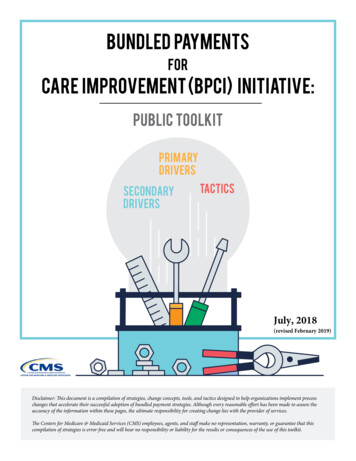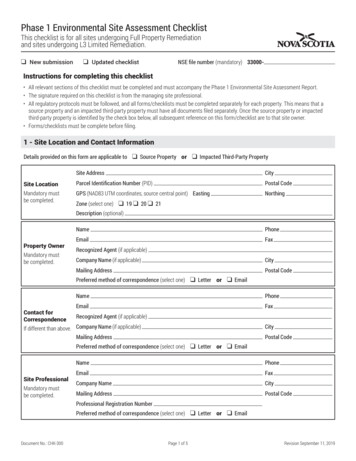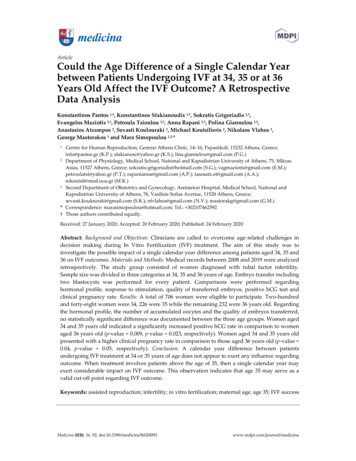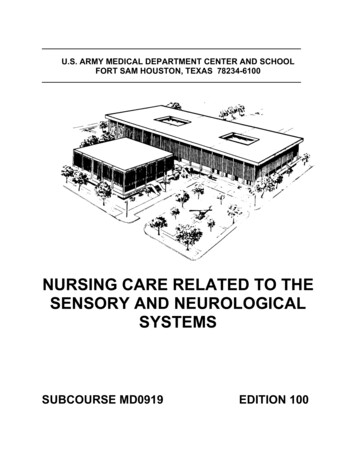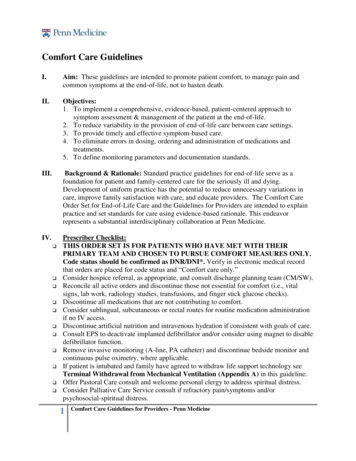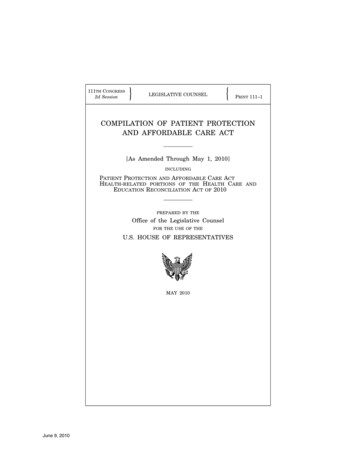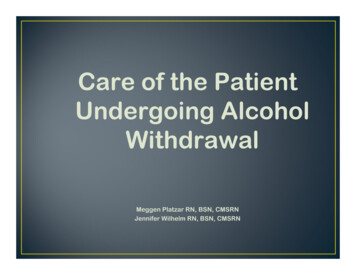
Transcription
Care of the PatientUndergoing AlcoholWithdrawalMeggen Platzar RN, BSN, CMSRNJennifer Wilhelm RN, BSN, CMSRN
“If you know someone who tries todrown their sorrows, you mighttell them sorrows know how toswim.”(Quoted in P.S. I Love You, compiled by H. Jackson Brown, Jr.)
Objectives Discuss statisticsDefine alcohol abuse, dependence and withdrawalDescribe effects of alcohol on the bodyDiscuss signs and symptoms alcohol withdrawalDiscuss the Clinical Institute Withdrawal of Alcohol Scale, RevisedDiscuss therapeutic interventions
Back to Basics: What is Alcohol? Alcohol, or ethanol, is produced by the fermentation of yeast,sugars and starches. Yeast breaks sugar down into ethanol andcarbon dioxide. Ethanol is water soluble and fat soluble, whichmeans it enters into the blood stream and passes through cellmembranes quickly.
Define Abuse and Dependence Alcohol Abuse: Recurrent harmful use of alcohol Alcohol Dependence (Alcoholism): Characterized by 4symptoms CravingLoss of controlPhysical dependenceTolerance
Who Uses Alcohol?According to theNationalsurveyon Drug useand health51.9% ofAmericansor 130.6 millionpeople,stated theywere currentdrinkersSource: SAMHSA, Office of AppliedStudies, National Survey on Drug Useand Health 2009 and 2010Alcohol Use: DemographicsTOTALPast Month: 2009(Percentage)Past Month: 2010(Percentage)51.951.812 to 1714.713.618 to 2561.861.526 or sian56.756.7Black or African American42.842.8American Indian or Alaska Native37.136.6Asian37.638.4Hispanic or Latino41.741.8AGEGENDERRACE
When it becomes too much In the US, about 1 in 16 adults have severe problems withdrinking. 27% of persons in the US between 18 - 64 years of age meetthe diagnostic criteria for alcohol dependency. Alcohol is one of the most abused drug in the US.
Risky BusinessAlcohol use increases your chances of Engaging in risky behaviorsExperiencing social and personal issuesExperiencing adverse health problemsBecoming a victim of injury
People who abuse alcohol have Mortality and Morbidity rates 2 - 4times greater than those of the general population.People who abuse alcohol have Mortality and Morbidity rates 2 - 4 times greaterthan those of the general population.
Quantifying Alcohol Abuse Different alcoholic beverages contain varying quantities ofalcohol. A daily intake of more than 60g of alcohol in menand 20g in women significantly increases the risk of cirrhosis. More than 4 drinks/day is considered heavy alcohol use forwomen, more than 5 drinks/day for men. There is no ABSOLUTE number of drinks per day or quantity ofalcohol that defines alcoholism.
Real Life Comparison of Ounces Each of these pictured beverages one alcoholic drink One alcoholic drink 12g alcohol
Effects on the Body Chronic drinking affects multiple organs Alcohol has damaging affects on the brain
How does Alcohol effect the Brain? Alcohol has a slowing or sedating effect on the CNS. NMDA GABA Chronic Drinkers Once the depressant effect of alcohol is removed, everymechanism will overact within hours of the last drink, resulting inAlcohol Withdrawal Syndrome.
Alcohol Withdrawal Syndrome (AWS) A set of signs and symptoms, including hyperactivity such asnausea, vomiting, sweating, shakiness, agitation and anxiety,that develop when alcohol use is stopped after a period ofheavy drinking. Can occur when a person who has been drinking too muchalcohol every day suddenly stops drinking.
Timing of Withdrawal SymptomsSyndromeClinical findingsOnset after last drinkMinor WithdrawalTremulousness, Mild anxiety, Headache,Diaphoresis, Palpitations, Anorexia, GIupset; Normal mental status6 to 36 hoursSeizuresSingle or brief flurry of generalized,Tonic-clonic seizures, Short post-ictalperiod; Status epilepticus rare6 to 48 hoursAlcoholic HallucinosisVisual, Auditory, and/or Tactilehallucinations (with intact orientation andnormal vital signs)12 to 48 hoursDelirium TremensDelirium, Agitation, Tachycardia,Hypertension, Fever, Diaphoresis48 to 96 hours
Alcohol Withdrawal Delirium(Delirium Tremens) Delirium Tremens (DTs) is a severe Alcohol Withdrawal Syndrome (AWS). (Itis the worst form of AWS). A complicated symptom, characterized by disturbance of consciousness,perceptual disturbance and marked autonomic hyperactivity. A state of severe confusion and visual hallucinating. 30% of patients with DTs develop Aspiration Pneumonia. A medical emergency! Very dangerous! Killing as many as 1 out of every20 people who develop its symptoms.
Just the FactsFACT: Even though alcohol withdrawal is a common in-patientdisorder, studies suggest that many hospitalized patients arenot receiving appropriate diagnosis or treatment.FACT: Alcohol dependence often remains hidden until withdrawalsigns appear. (Example: Hospitalized patient)
Statistics in Hospitals In 2009, 32% of all ED visits involving drug abuse, wererelated to the use of alcohol. 1 in every 4 - 5 patients admitted to the hospital has a problemwith alcohol. In another study, 226,000 patients were discharged from shortstay Hospitals (excluding VA and Federal Institutions) with 1 ofthe following diagnoses: Alcohol withdrawal, Alcoholwithdrawal delirium or Alcohol withdrawal hallucinosis.
Nursing Care for the PatientWithdrawing from AlcoholManagement Goals for Alcohol Withdrawal Prevent the progression of symptoms Provide for the patient’s safety and comfort Motivate the patient to engage in long term treatment
In-patient Screening Who should be screened? All patients should be screened for alcohol abuse uponadmission Statistics show that up to 40% of patients admitted to thehospital may have some alcohol dependency
Screening: The Interview As part of the admission assessment and history Do you consume 3 or more drinks a week? Date of the last alcoholic drink consumed?I have a few when I takeclients out for lunch, andthen I have a drink towind down after myworkday
Screening: Physical ExamSystem AffectedEffectsCNSImpaired memory, Coordination, Sleepdisturbances, Neuropathy, HallucinationsCardiovascularCardiomyopathy, Dysrhythmias,HypertensionHemoThrombocytopenia, AnemiaGastrointestinalEsophageal inflammation, Varices,Pancreatitis, Cirrhosis, Nausea andVomitingMuskoskeletalMalnutrition, Weakness, Tremors(Alcohol tremulousness)
Screening: Lab TestsLFTs: Liver Function Tests AST: aspartate aminotransferase ALT: alanine aminotransferase AST/ALT ratio ALP: alkaline phosphataseThere are various reasons why liverenzymes could be elevated
Lab Tests Cont. Serum Albumin ConcentrationGamma Glutamyltranspeptidase (GGT)Total BilirubinPT/INRCBCCMP Ethyl Glucuronide
Identifying AWS Screening can help us identify people who are at risk fordeveloping AWS Physical exam: Can display physical symptoms that support theinterview The key to identifying AWS is ruling out other medicalconditions that could be causing any signs and symptoms
Treatment Strategies The Clinical Institute Withdrawal Assessment of Alcohol Scale,revised (CIWA-Ar) Created to assess and guide treatment of acute alcohol withdrawal. Can be used objectively to assess for the development of AWS Validated objective scaleHas a list of 10 signs and symptomsQuick, Easy to use, UsefulHas well documented reliability, reproducibility and validity
Score Assigned Score assigned to each symptom A cumulative score determines therapy for the patient 10: very mild withdrawal10 - 15: mild withdrawal16 - 20: Modest withdrawal 20: severe, poses strong risk for delirium tremensMaximum score is 67
Cascade of Interventions The CIWA score can be used to : 1. Determine severity of withdrawal2. Determine frequency of assessment3. Determine dose and frequency of medication administration4. Nursing interventions
Frequency of Assessment Repeat CIWA-Ar assessment questions Every 1, 2 to 8 hours depending on score Notify physician if CIWA –Ar score 20,if patient experiencing DTs, or if there is a needfor restraints.
Pharmacological Treatment Benzodiazepines: considered by research studies andconsensus reports to be the drug of choice to treatalcohol withdrawal Symptom-triggered dosing vs. scheduled dosing Often, only 1 – 2 days of medication administration isneeded and no tapering
Why Benzodiazepines? Act upon the Central Nervous System the same way alcoholdoes, therefore suppressing the nervous system and preventingthe over excitability that sudden alcohol cessation causes. Diazepam (Valium) Lorazepam (Ativan)Main Campus: Drugs ofchoice are ativan andvalium determined bycertain criteria
Nursing Interventions Safety Fall risk Restraints Hourly rounding Aspiration precautions Nausea/Vomiting Suction Nasogastric tube Cardiac Monitoring Dysrhythmias Vital Signs
Nutrition Vitamin B1 (Thiamine) Wernicke’s Encephalopy Korsakoff’s Psychosis Electrolytes Frequent meals and snacks Fluids Intake and Output
Consults Nutrition therapyPsychiatryCase ManagementSocial Work Assess for barriers Outpatient Resources AA Substance Abuse Treatment Centers
Barriers to Cessation
Patient Education Cessation of alcohol use Nutrition Resources
Stacey is a 34 year old small business owner who is admitted toyour unit after being involved in a MVA. Her PMH includesasthma and poly drug use. Her last use was 12 months ago withthe exception of the glass of wine she has daily with dinner. On day 2, the next day after admission, Stacey is exhibiting signs of mildnausea without emesis, moderate anxiety and seems somewhat agitated.She is c/o of a HA that “just won’t quit.” On day 3, Stacey calls and asks that blinds be closed because the Augustsun is too bright and hurting her HA. You tell Stacey it’s September andwhen asking her questions you notice she is restless and fidgeting with herblankets which are drenched with sweat.
Bibliography Bayard, M. MD, McIntyre, J. MD, Hill, K. MD and Woodside, J. Jr. MD (2004, March). Alcohol WithdrawalSyndrome, American Family Physician, 15, 69(6), 1443-1450.Fairbanks, K. MD (2010, August 1). Alcoholic Liver Disease. Retrieved March 20, 2011, /Hartsell, Z. PA-C, Drost, J. PA-C, Wilkins, J. MD and Budavari, A. MD (2007, September 01). ManagingAlcohol Withdrawal In Hospitalized Patients, Journal of the American Academy of Physician Assistants.Alcohol Dependence (Alcoholism). Retrieved 3/30/2011, fromhttp://www.intelihealth.com/IH/ihtIH?d dmtHealthAZ&c 266750&p br,IHW st,24479 r,WSIHW000 b,* Alcohol Withdrawal. Retrieved 3/30/2011, fromhttp://www.intelihealth.com/IH/ihtIH?t 25726&p br,IHW st,24479 r,WSIHW000 b,* Kelly, A. and Saucier, J. (2004, February). Is Your Patient Suffering From Alcohol Withdraw?, RN, 67(2), 2731.Keys, V. (2011, January). Alcohol Withdrawal During Hospitalization, American Journal of Nursing, 111, 4044.McKay, A., Koranda, A. and Axen, D. (2004, February). Using A Symptom-Triggered Approach To ManagePatients In Acute Alcohol Withdrawal, MedSurg Nursing.McKinley, M.G. (2005, June). Alcohol Withdrawal Syndrome Overlooked And Mismanaged?, Critical CareNurse, 25, 40-49.
Bibliography Continued
not receiving appropriate diagnosis or treatment. FACT: Alcohol dependence often remains hidden until withdrawal signs appear. (Example: Hospitalized patient) . American Journal of Nursing, 111, 40-44. McKay, A., Koranda, A. and Axen, D. (2004, February). Using A Symptom-Triggered Approach To Manage Patients In Acute Alcohol Withdrawal .




